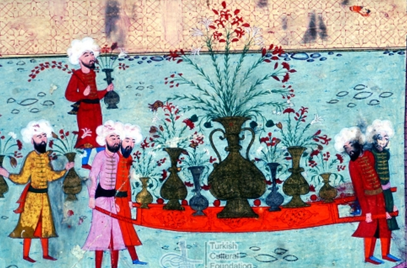The floral genre of Iznik ceramics fascinated 16th-century European travellers. Their comments on the meaning of flowers and gardens in the Ottoman culture can help us understand why Iznik artisans favoured floral motifs.
To many European travellers, Ottoman floriculture was a newsworthy novelty. Pierre Belon du Mans, a herbalist who travelled in quest of plants throughout the Ottoman empire (1546-1549) in the entourage of the French ambassador to Süleyman the Magnificent, noted that,
There are no people who so much delight in beautiful flowers as the Turks, when they find a beautiful wallflower or some other graceful flower, even though it has no smell they do not prize it the less. We like to have bunches of different kinds of scented flowers mixed together, but the Turks care only for sight rather than smell, and like to have only one flower at a time. Even if they may have several different kinds of flowers it is their custom to wear only a single flower in the folds of their turban. Artisans commonly have several flowers of different colours in a jar of water in front of them, to keep them fresh in their beauty. And so the Turks think as much of their gardens as we do, and go to great trouble to get exotic trees, particularly those that have beautiful flowers, and grudge no money for the purpose.[1]
Pierre Belon projected the Ottomans’ delicate tastes and passion for, beautiful flowers [which] are held in high esteem
. Istanbul in the 16th century, according to Belon, was an international marketplace for knowledgeable horticulturists where, so many foreigners who come to Constantinople in ships from other countries bring with them roots of plants which have beautiful flowers and sell them in the markets, and from all the things that they bring they make money
.

Surname-ì Humayün (The book of Imperial festivities), written by famous court annalist Seyyid Lokman and Illustrated by Nakkaş Osman 1582.
Ottoman floriculture had a further notice from Ogier Ghiselin de Busbecq, a Flemish diplomat who resided in the Ottoman lands (1555-1562).[2]
On his journey from Adrianople to Constantinople, de Busbecq wrote in his letters, we everywhere came across quantities of flowers -narcissi, hyacinths and tulipans, as the Turks call them. We were surprised to find them flowering in mid-winter, scarcely a favourable season
. Busbecq also observed that the Ottoman do not allow rose-leaves to lie on the ground, because they think that the rose sprang from the sweat of Mahomet, just as the ancients believed that it came from the blood of venus
.
References
[1] Travels in the Levant: The Observations of Pierre Belon du Mans (1553). (ed.) Alexandra Merle. (trans.) James Hogarth. (UK: Harding Simpole). Chapter 51, p. 469.
[2] The Life and Letters of Ogier Ghiselin de Busbecq. (eds. and trans.) Charles Thornton Foster and F.H. Blackburne Daniell New York: Cambridge University Press. Vol.1, Letter I, p. 107-110.
Back to Iznik Dish

